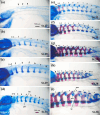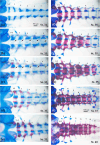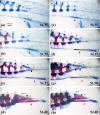Perichordal Vertebral Column Formation in Rana kobai
- PMID: 40181708
- PMCID: PMC11987488
- DOI: 10.1002/jmor.70044
Perichordal Vertebral Column Formation in Rana kobai
Abstract
The vertebral column of anurans exhibits morphological diversity that is often used in phylogenetic studies. The family Ranidae is one of the ecologically most successful groups of anurans, with the genus Rana being distributed broadly in Eurasia. However, there are relatively sparse detailed studies on the development of the vertebral column in Rana species, and images of the entire axial skeleton have seldom been illustrated till date. Here, we provide an illustrated description on the development of the entire vertebral column in Rana kobai, a Japanese small frog from the Amami Islands. Our observation of double-stained skeletal specimens revealed that in R. kobai, the original atlas and the first dorsal are fused into one vertebra, and the ninth neural arch is fused with the tenth arch in half of the examined larvae. Anuran vertebral column development is classified into two modes, perichordal and epichordal. Rana species undergo the typical perichordal mode of centrum formation. Kemp and Hoyt (1969) described that centrum formation in R. pipiens starts from a saddle-shaped bone on the dorsal half of the notochord. Nevertheless, our detailed observations revealed that centrum ossification initially emerges at the base of the paired neural arches and then forms the saddle-shaped bone. In Xenopus, a species with epichordal centra, centrum formation starts from a pair of ovoid bone elements at the base of the neural arches. Overall, our results imply that centrum ossification starts from the base of neural arches in anurans, irrespective of whether it is perichordal or epichordal. Our observations also revealed the presence of the crescent-shaped cartilage domain in the intervertebral region in R. kobai. The location of the crescent-shaped domain in R. kobai is consistent with that of the intercentrum in Ichthyostega and several temnospondyls. Based on our observations, we propose a hypothesis on the difference between perichordal and epichordal modes in light of evolution.
Keywords: Anura; Rana; centrum; vertebral column.
© 2025 Wiley Periodicals LLC.
Conflict of interest statement
The authors declare no conflicts of interest.
Figures








Similar articles
-
Epichordal vertebral column formation in Xenopus laevis.J Morphol. 2024 Feb;285(2):e21664. doi: 10.1002/jmor.21664. J Morphol. 2024. PMID: 38361270
-
Skeletal morphogenesis of the vertebral column of the miniature hylid frog Acris crepitans, with comments on anomalies.J Morphol. 2009 Jan;270(1):52-69. doi: 10.1002/jmor.10665. J Morphol. 2009. PMID: 18946872
-
The metamorphic fate of supernumerary caudal vertebrae in South Asian litter frogs (Anura: Megophryidae).J Anat. 2007 Sep;211(3):271-9. doi: 10.1111/j.1469-7580.2007.00757.x. Epub 2007 Jun 8. J Anat. 2007. PMID: 17559539 Free PMC article.
-
Building the backbone: the development and evolution of vertebral patterning.Development. 2015 May 15;142(10):1733-44. doi: 10.1242/dev.118950. Development. 2015. PMID: 25968309 Review.
-
A critical review of the 'neugliederung' concept in relation to the development of the vertebral column.Acta Biotheor. 1976;25(4):219-58. doi: 10.1007/BF00046818. Acta Biotheor. 1976. PMID: 829011 Review.
References
-
- Adolphi, H. 1892. “Über Variationen der Spinalnerven und der Wirbelsäule anurer Amphibien. I. (Bufo variabilis Pall.).” Gegenbaurs Morphologisches Jahrbuch 19: 313–375.
-
- Adolphi, H. 1895. “Über Variationen der Spinalnerven und der Wirbelsäule anurer Amphibien. II. (Pelobates fuscus Wagl. und Rana esculenta L.).” Gegenbaurs Morphologisches Jahrbuch 22: 449–490.
-
- Báez, A. M. , and Nicoli L.. 2004. “A New Look at an Old Frog: The Jurassic Notobatrachus Reig From Patagonia.” Ameghiniana 41: 257–270.
MeSH terms
LinkOut - more resources
Full Text Sources

